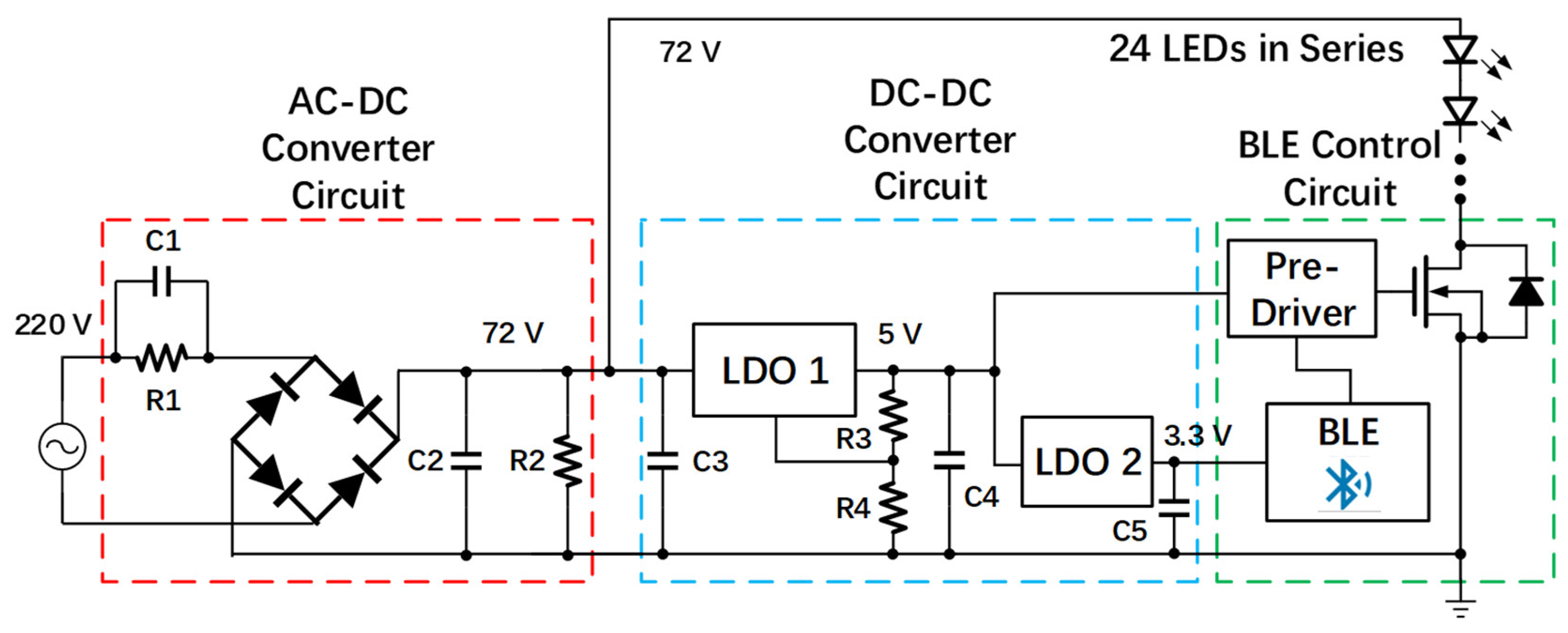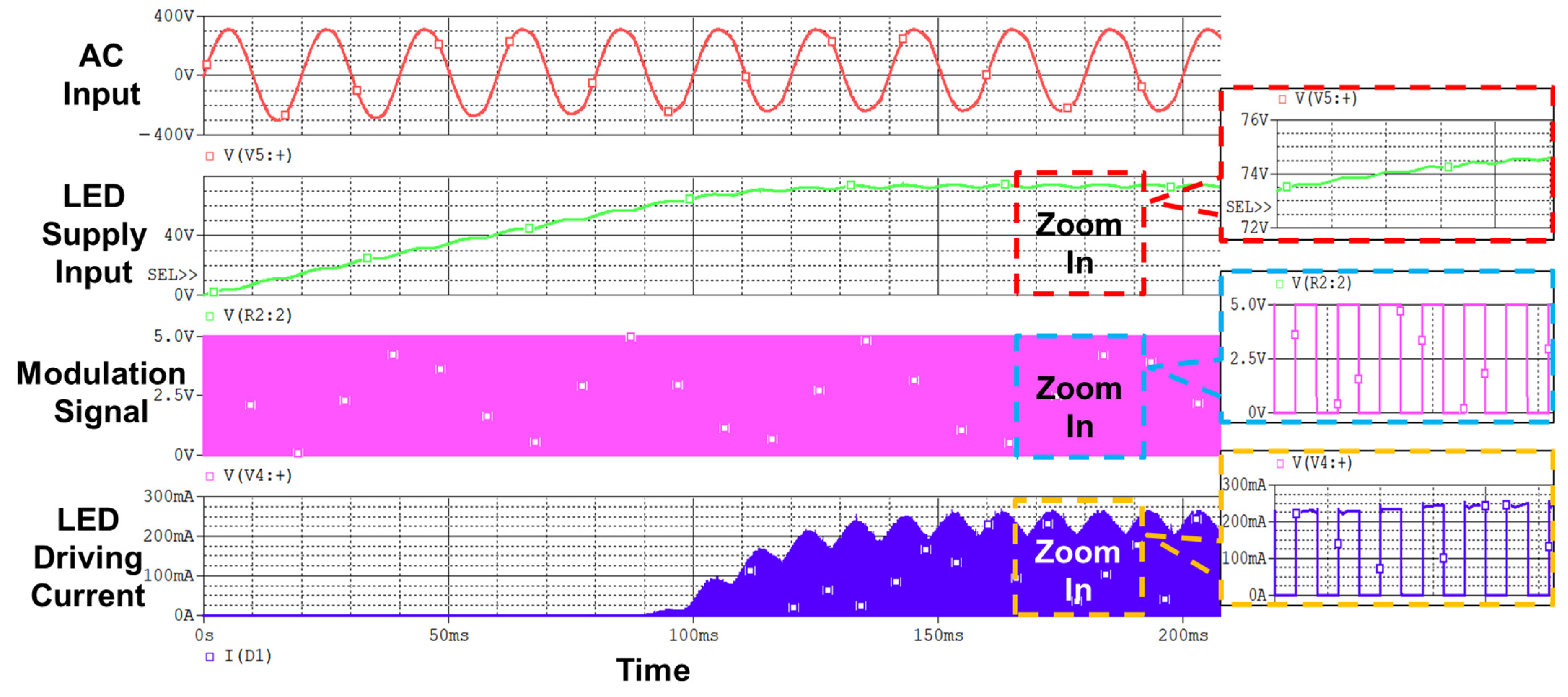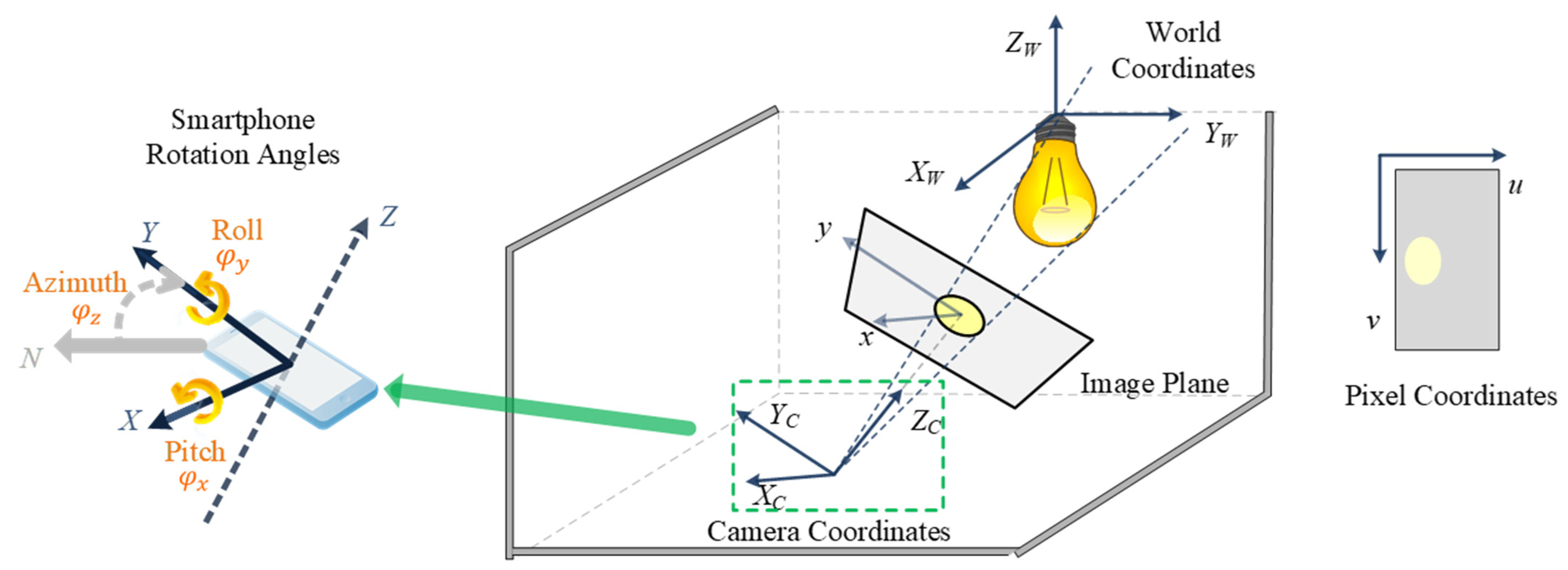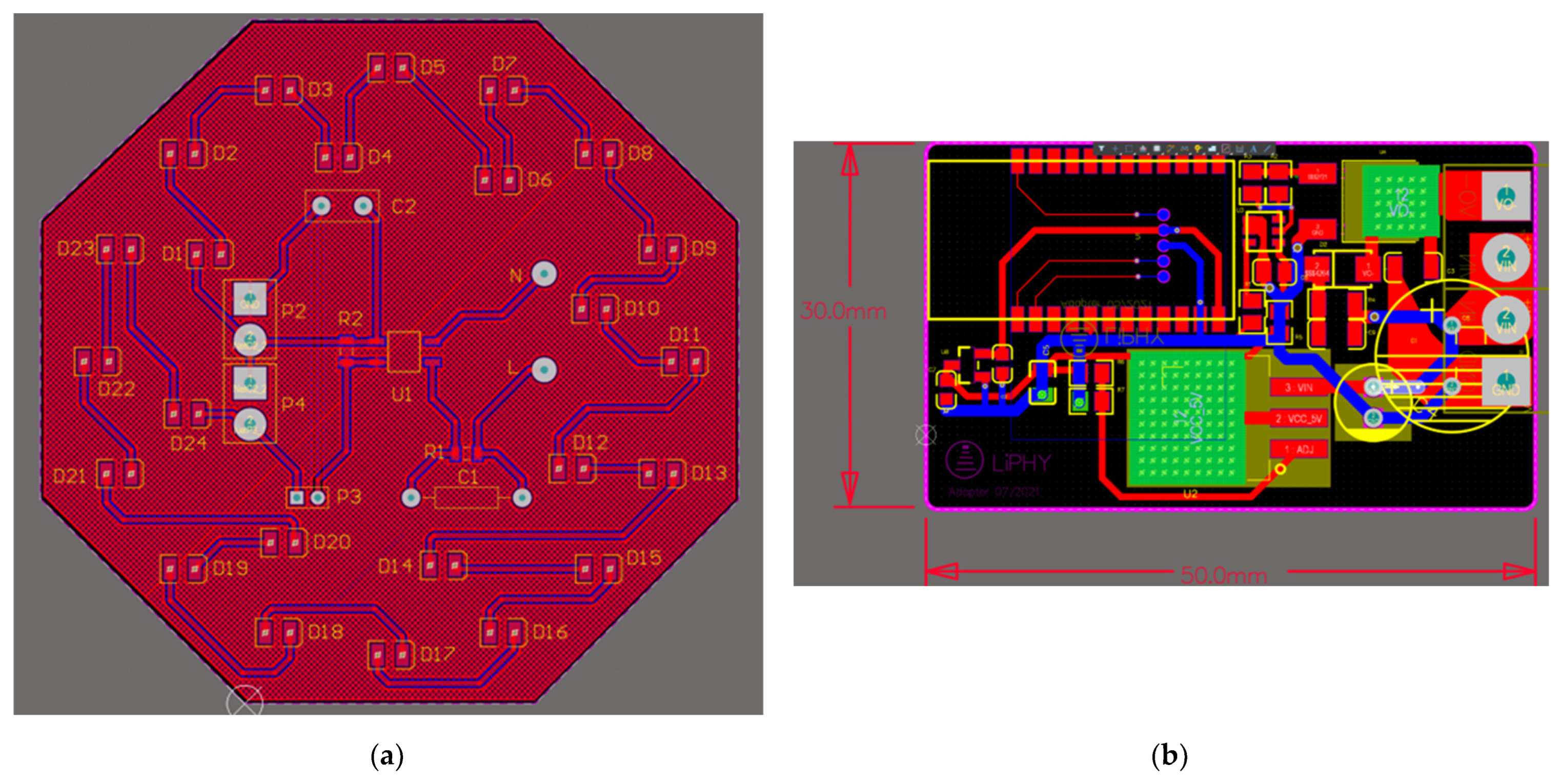Smart Home Control System Using VLC and Bluetooth Enabled AC Light Bulb for 3D Indoor Localization with Centimeter-Level Precision
Abstract
:1. Introduction
- (1)
- We aim to solve the low control accuracy problem and security issue in traditional RF-based smart home control systems.
- (2)
- We aim to solve the practical implementation problem of the VLC system and meet the requirements for real-world application.
- (3)
- We aim to solve the problem of low-accuracy indoor localization of users in SHSs by utilizing the VLP algorithm.
- (1)
- We propose a VLC-enabled smart home control system with the combination of Bluetooth communication. The proposed system aims to solve the limited control accuracy and security issues existing in traditional RF-based control systems. This system consists of a VLC lightbulb as a transmitter, a smartphone application-based receiver, and a back-end cloud server. These three key elements cooperate to provide precise and secure control of smart devices by dividing the whole control region into different rooms according to the position of the VLC lightbulb.
- (2)
- We present the design of a driverless AC-powered VLC lightbulb for the practical implementation of the VLC system. This VLC lightbulb is designed to solve the problems and meet the real-world application requirements for our proposed smart home control system. It is characterized by compact size, standard form factor, and plug-n-play functionality. Moreover, it supports wireless control via Bluetooth for remotely managing its working states and transmitted information, which brings convenience to users.
- (3)
- We propose a directional-angle-assisted 3D indoor VLP algorithm to acquire the precise 3D world coordinates of the user to compensate for the low user position accuracy in SHSs. With this proposed VLP algorithm, the user’s position can be calculated with centimeter-level accuracy. In addition, this algorithm can be adapted to orientation-based and location-based applications for extending diversity.
2. Related Works
3. Theoretical Analysis of Proposed Smart Home Control System
3.1. Architecture Design of Smart Home Control with Cloud Server
3.2. Design of VLC LED Lightbulb
3.3. Smart Home Control with Directional Angle Data Assisted 3D Indoor VLP Algorithm
4. Smart Home Control System Prototype and Performance Evaluation
4.1. Prototype of VLC Lightbulb
4.2. Performance Evaluation of VLC-Based Smart Home Control System
4.3. Verification of Directional Angle Data Assisted 3D Indoor VLP Algorithm
5. Conclusions
Author Contributions
Funding
Institutional Review Board Statement
Informed Consent Statement
Data Availability Statement
Conflicts of Interest
References
- Al-Fuqaha, A.; Guizani, M.; Mohammadi, M.; Aledhari, M.; Ayyash, M. Internet of Things: A Survey on Enabling Technologies, Protocols, and Applications. IEEE Commun. Surv. Tutor. 2015, 17, 2347–2376. [Google Scholar] [CrossRef]
- Alam, M.R.; Reaz, M.B.I.; Ali, M.A.M. A review of smart homes—Past, present, and future. IEEE Trans. Syst. Man Cybern. C Appl. Rev. 2012, 42, 1190–1203. [Google Scholar]
- Zamora-Izquierdo, M.A.; Santa, J.; Gomez-Skarmeta, A.F. An Integral and Networked Home Automation Solution for Indoor Ambient Intelligence. IEEE Pervasive Comput. 2010, 9, 66–77. [Google Scholar] [CrossRef]
- Ahmed, S.; Kim, D. Named data networking-based smart home. ICT Express 2016, 2, 130–134. [Google Scholar] [CrossRef] [Green Version]
- Jeon, K.E.; She, J.; Soonsawad, P.; Ng, P.C. BLE Beacons for Internet of Things Applications: Survey, Challenges, and Opportunities. IEEE Internet Things J. 2018, 5, 811–828. [Google Scholar] [CrossRef]
- Alvi, A.N.; Bouk, S.H.; Ahmed, S.H.; Yaqub, M.A.; Sarkar, M.; Song, H. BEST-MAC: Bitmap-assisted effcient and scalable TDMA-based WSN MAC protocol for smart cities. IEEE Access 2016, 4, 312–322. [Google Scholar]
- Brena, R.F.; García-Vázquez, J.P.; Galván-Tejada, C.E.; Muñoz-Rodriguez, D.; Vargas-Rosales, C.; Fangmeyer, J. Evolution of Indoor Positioning Technologies: A Survey. J. Sens. 2017, 2017, 2630413. [Google Scholar] [CrossRef]
- Komninos, N.; Philippou, E.; Pitsillides, A. Survey in Smart Grid and Smart Home Security: Issues, Challenges and Countermeasures. IEEE Commun. Surv. Tutor. 2014, 16, 1933–1954. [Google Scholar] [CrossRef]
- Santoso, F.K.; Vun, N.C.H. Securing IoT for smart home system. In Proceedings of the 2015 International Symposium on Consumer Electronics (ISCE), Madrid, Spain, 24–26 June 2015; pp. 1–2. [Google Scholar]
- Komine, T.; Nakagawa, M. Fundamental analysis for visible-light communication system using LED lights. IEEE Trans. Consum. Electron. 2004, 50, 100–107. [Google Scholar] [CrossRef]
- Li, L.; Hu, P.; Peng, C.; Shen, G.; Zhao, F. Epsilon: A visible light based positioning system. In Proceedings of the 11th USENIX Symposium on Networked System Design and Implementation (NSDI), Seattle, WA, USA, 2–4 April 2014; pp. 331–343. [Google Scholar]
- Depatla, S.; Muralidharan, A.; Mostofi, Y. Occupancy Estimation Using Only WiFi Power Measurements. IEEE J. Sel. Areas Commun. 2015, 33, 1381–1393. [Google Scholar] [CrossRef]
- Tekler, Z.D.; Low, R.; Gunay, B.; Andersen, R.K.; Blessing, L. A scalable Bluetooth Low Energy approach to identify occupancy patterns and profiles in office spaces. Build. Environ. 2020, 171, 106681. [Google Scholar] [CrossRef]
- Hahnel, D.; Burgard, W.; Fox, D.; Fishkin, K.; Philipose, M. Mapping and localization with RFID technology. In Proceedings of the IEEE International Conference on Robotics and Automation (ICRA), New Orleans, LA, USA, 26 April–1 May 2004; pp. 1015–1020. [Google Scholar]
- Liu, D.; Guan, X.; Du, Y.; Zhao, Q. Measuring indoor occupancy in intelligent buildings using the fusion of vision sensors. Meas. Sci. Technol. 2013, 24, 074023. [Google Scholar] [CrossRef]
- Hussain, B.; Li, X.; Che, F.; Yue, C.P.; Wu, L. Visible Light Communication System Design and Link Budget Analysis. J. Light. Technol. 2015, 33, 5201–5209. [Google Scholar] [CrossRef]
- Xu, B.; Hussain, B.; Liu, X.; Min, T.; Cheng, H.C.; Yue, C.P. Smart-home control system using VLC-enabled high-power LED lightbulb. In Proceedings of the 2021 IEEE 10th Global Conference on Consumer Electronics (GCCE), Kyoto, Japan, 12–15 October 2021; pp. 744–745. [Google Scholar]
- Davidoff, S.; Lee, M.K.; Yiu, C.; Zimmerman, J.; Dey, A.K. Principles of smart home control. In Proceedings of the 2006 8th International Conference on Ubiquitous Computing (UbiComp), Orange County, CA, USA, 17–21 September 2006; pp. 19–34. [Google Scholar]
- Li, M.; Lin, H.-J. Design and Implementation of Smart Home Control Systems Based on Wireless Sensor Networks and Power Line Communications. IEEE Trans. Ind. Electron. 2015, 62, 4430–4442. [Google Scholar] [CrossRef]
- Han, J.; Choi, C.-S.; Park, W.-K.; Lee, I.; Kim, S.-H. PLC-based photovoltaic system management for smart home energy management system. IEEE Trans. Consum. Electron. 2014, 60, 184–189. [Google Scholar] [CrossRef]
- Al-Ali, A.; Zualkernan, I.A.; Rashid, M.; Gupta, R.; Alikarar, M. A smart home energy management system using IoT and big data analytics approach. IEEE Trans. Consum. Electron. 2017, 63, 426–434. [Google Scholar] [CrossRef]
- Mao, X.; Li, K.; Zhang, Z.; Liang, J. Design and implementation of a new smart home control system based on internet of things. In Proceedings of the 2017 International Smart Cities Conference (ISC2), Wuxi, China, 14–17 September 2017; pp. 1–5. [Google Scholar] [CrossRef]
- Zhang, L.; Leung, H.; Chan, K.C. Information fusion based smart home control system and its application. IEEE Trans. Consum. Electron. 2008, 54, 1157–1165. [Google Scholar] [CrossRef]
- Han, D.-M.; Lim, J.-H. Smart home energy management system using IEEE 802.15.4 and zigbee. IEEE Trans. Consum. Electron. 2010, 56, 1403–1410. [Google Scholar] [CrossRef]
- Han, D.-M.; Lim, J.-H. Design and implementation of smart home energy management systems based on zigbee. IEEE Trans. Consum. Electron. 2010, 56, 1417–1425. [Google Scholar] [CrossRef]
- Tiwari, S.V.; Sewaiwar, A.; Chung, Y.H. Smart home technologies using visible light communication. In Proceedings of the 2015 IEEE International Conference on Consumer Electronics (ICCE), Las Vegas, NV, USA, 9–12 January 2015; pp. 379–380. [Google Scholar]
- Lee, Y.U.; Kang, K.; Choi, G. Secure visible light encryption communication technique for smart home service. In Proceedings of the 2019 IEEE 9th Annual Computing and Communication Workshop and Conference (CCWC), Las Vegas, NV, USA, 7–9 January 2019; pp. 827–831. [Google Scholar]
- Haus, M.; Ding, A.Y.; Ott, J. LocalVLC: Augmenting smart IoT services with practical visible light communication. In Proceedings of the 2019 IEEE 20th International Symposium on “A World of Wireless, Mobile and Multimedia Networks” (WoWMoM), Washington, DC, USA, 10–12 June 2019; pp. 1–9. [Google Scholar]
- Kandt, A.J.; Margarete, R.L. Plug Load Management System Field Study; No. NREL/TP-7A40-72028; National Renewable Energy Lab. (NREL): Golden, CO, USA, 2019.
- Tekler, Z.D.; Low, R.; Yuen, C.; Blessing, L. Plug-Mate: An IoT-based occupancy-driven plug load management system in smart buildings. Build. Environ. 2022, 223, 109472. [Google Scholar] [CrossRef]
- Park, S.; Choi, M.-I.; Kang, B.; Park, S. Design and Implementation of Smart Energy Management System for Reducing Power Consumption Using ZigBee Wireless Communication Module. Procedia Comput. Sci. 2013, 19, 662–668. [Google Scholar] [CrossRef]
- Hussain, B.; Lau, C.; Yue, C.P. Li-Fi based secure programmable QR code (LiQR). In Proceedings of the JSAP-OSA Joint Symposia 2017 Abstracts, Fukuoka, Japan, 18–21 September 2017; p. 6p_A409_6. [Google Scholar]
- Hussain, B.; Qiu, C.; Yue, C.P. A universal VLC modulator for retrofitting LED lighting and signage. In Proceedings of the 2019 IEEE 8th Global Conference on Consumer Electronics (GCCE), Osaka, Japan, 15–18 October 2019; pp. 1008–1009. [Google Scholar]
- Qiu, C.; Hussain, B.; Yue, C.P. Bluetooth based wireless control for iBeacon and VLC enabled lighting. In Proceedings of the 2019 IEEE 8th Global Conference on Consumer Electronics (GCCE), Osaka, Japan, 15–18 October 2019; pp. 614–615. [Google Scholar]
- Wang, Y.; Hussain, B.; Yue, C.P. Arbitrarily Tilted Receiver Camera Correction and Partially Blocked LED Image Compensation for Indoor Visible Light Positioning. IEEE Sens. J. 2022, 22, 4800–4807. [Google Scholar] [CrossRef]
- Zhang, R.; Zhong, W.-D.; Kemao, Q.; Zhang, S. A Single LED Positioning System Based on Circle Projection. IEEE Photon- J. 2017, 9, 7905209. [Google Scholar] [CrossRef]
- Lee, J.-W.; Kim, S.-J.; Han, S.-K. 3D Visible Light Indoor Positioning by Bokeh Based Optical Intensity Measurement in Smartphone Camera. IEEE Access 2019, 7, 91399–91406. [Google Scholar] [CrossRef]











| Reference | Year of Publication | Adopted Technology | Communication Method | Core Devices |
|---|---|---|---|---|
| [19,20] | 2015, 2014 | PLC + WSN | PLC + ZigBee | ZigBee coordinator, power line, PLC TRx |
| [21,22] | 2017 | IoT + big data | Wi-Fi | Microcontroller, sensors, cloud server, smartphone |
| [23] | 2008 | Information fusion | Bluetooth + PLC | IF-based controller, power line, computational unit |
| [24,25] | 2010 | ZigBee | ZigBee | RF-based devices, sensors |
| [26,27,28] | 2019 | VLC | VLC | Evaluation board, smart home gateway, smartphone |
| This Work | / | VLC + VLP | VLC + BLE + Wi-Fi/LTE | VLC lightbulb, cloud server, smartphone |
| Typical Methods | PLC | IoT | Information Fusion | ZigBee | VLC | VLC + BLE + VLP | |
|---|---|---|---|---|---|---|---|
| System Scalability | Low | High | Middle | High | Low | High | |
| User Convenience | Middle | High | High | Middle | Low | High | |
| Control Accuracy | High | Low | Middle | Low | Middle | High | |
| Considered | Security Issue | No | No | No | No | Yes | Yes |
| Indoor Positioning | No | No | No | No | No | Yes | |
| Operating Voltage of LEDs | Driving Current of LEDs | Total Electric Power | VLC Link Distance | Illuminance at 1.5 m |
|---|---|---|---|---|
| 74.2 V | 139 mA | 10.3 W | 3.4 m | 362.5 lx |
| Location | Direction Angles | (cm) | (cm) | (cm) | PER |
|---|---|---|---|---|---|
| Position 1 | = 40, = 0, = 0 | −151 | 0 | 81 | 6.72% |
| Position 2 | = −23, = −39, = 90 | −117 | −54 | 88 | 6.87% |
| Position 3 | = −18, = −4, = 90 | −10 | −49 | 109 | 6.23% |
| Position 4 | = 20, = 8, = 90 | 0 | 41 | 84 | 7.41% |
Publisher’s Note: MDPI stays neutral with regard to jurisdictional claims in published maps and institutional affiliations. |
© 2022 by the authors. Licensee MDPI, Basel, Switzerland. This article is an open access article distributed under the terms and conditions of the Creative Commons Attribution (CC BY) license (https://creativecommons.org/licenses/by/4.0/).
Share and Cite
Xu, B.; Hussain, B.; Wang, Y.; Cheng, H.C.; Yue, C.P. Smart Home Control System Using VLC and Bluetooth Enabled AC Light Bulb for 3D Indoor Localization with Centimeter-Level Precision. Sensors 2022, 22, 8181. https://doi.org/10.3390/s22218181
Xu B, Hussain B, Wang Y, Cheng HC, Yue CP. Smart Home Control System Using VLC and Bluetooth Enabled AC Light Bulb for 3D Indoor Localization with Centimeter-Level Precision. Sensors. 2022; 22(21):8181. https://doi.org/10.3390/s22218181
Chicago/Turabian StyleXu, Bo, Babar Hussain, Yiru Wang, Hoi Chuen Cheng, and Chik Patrick Yue. 2022. "Smart Home Control System Using VLC and Bluetooth Enabled AC Light Bulb for 3D Indoor Localization with Centimeter-Level Precision" Sensors 22, no. 21: 8181. https://doi.org/10.3390/s22218181





